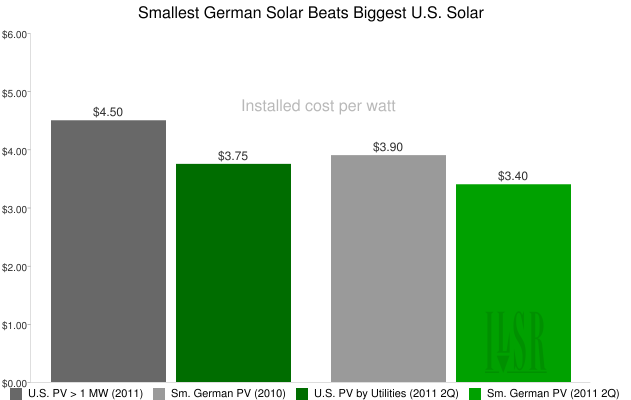This post originally appeared on Energy Self-Reliant States, a resource of the Institute for Local Self-Reliance’s New Rules Project.
The U.S. has a hodge-podge of utility, state, and federal tax-based incentives. The Germans have a comprehensive feed-in tariff, providing CLEAN contracts (in the U.S. parlance) to anyone who wants to go solar (or wind, or biogas, etc). What does that mean for the price of solar?
From a study of U.S. solar prices reported in Renewables International:
Perhaps most surprisingly, the study found that the planned arrays [in the U.S.] larger than one megawatt have an average installed price of $4.50 per watt, with only a third of the systems in the pipeline coming in at prices below four dollars per watt. As Renewables International reported in January, the installed system price of photovoltaics in the US was easily 60 percent above the level in Germany in 2010 for equivalent system sizes (arrays smaller than 100 kilowatts). [Emphasis added.]
While large-scale U.S. solar comes in at $4.50 per Watt, small-scale German solar (10-100 kilowatts) averaged $3.90 per Watt in 2010 and $3.40 per Watt in the second quarter of 2011. he German price advantage in solar is like having a pint of your favorite craft or microbrew beer for less than a Budweiser.
Of course, price comparisons are tricky, because the U.S. has no clearinghouse for solar installation data (again, the result of its hodge-podge federal-state-local policies). A just-released study of U.S. solar prices by the Solar Energy Industries Association found utility-constructed solar in the U.S. is now being installed at $3.75 per Watt. It’s not clear how much overlap there is between that data and the Renewables International report of $4.50 per Watt for solar 1 megawatt and larger.
Either way, small German rooftop solar is still beating U.S. large-scale solar. Here’s a chart illustrating that cost differential, with U.S. and German prices updated for the 2nd quarter of 2011.
If the German solar prices are wunderbar, that makes the U.S. “furchtbar.”




